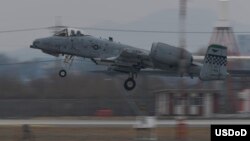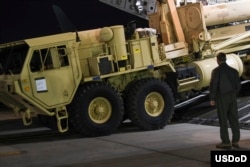Amid reports that the White House is reviewing its policy toward North Korea, the former head of the U.S. Pacific Command says it's crucial to consider a full range of options — including the use of military force, if necessary — to deter the growing nuclear threat from Pyongyang.
In an interview with VOA Tuesday, Admiral Samuel Locklear, who led the U.S. Pacific Command from 2012 to 2015, said "dealing across the spectrum of options of how to deal with North Korea is becoming more urgent," given the communist state's apparent eagerness to demonstrate its nuclear capability.
"Certainly there are many elements of national and coalition power that range from diplomatic to economic," Locklear said, "but at the base of all of those would be military power that the U.S. and its allies must continue to consider, particularly when there remains a significant threat such as from what we see in North Korea."
Exploring options
Locklear's assessment came a day after North Korea launched at least four ballistic missiles, once again escalating tensions on the Korean peninsula.
Asked whether the U.S. should draw a red line marking a limit for the North's nuclear ambitions, Locklear said Washington needs to ensure it does not wind up in a position of having to deal with Pyongyang as a de facto nuclear state.
North Korean state media said Monday's launches were part of military drills, practice attacks on U.S. military bases in Japan. Three of the four missiles traveled about 1,000 kilometers before landing in the Sea of Japan off the Oga Peninsula, waters that Japan claims as its exclusive economic zone.
The missile launches also coincided with U.S.-South Korean joint military exercises — an annual event that Pyongyang contends is a rehearsal for invasion.
Advancing missile program
Experts suggested two possible reasons for the North's test launches: advancing its missile program and sending a political message to neighboring countries.
"They have an accelerated [missile] program in mind, and they are moving ahead to try to implement the program," Robert Einhorn, a special adviser for nonproliferation and arms control in the Obama administration, told VOA.
John Park, a northeast Asia specialist at the Harvard Kennedy School, also stressed the technical component of the test, saying North Korea is continuing its ballistic missile tests to eventually be able to "put together what would be its first ICBM with nuclear capabilities."
Jim Walsh, a senior research associate at Massachusetts Institute of Technology's Security Studies Program, sees the North Korean move as a protest against the joint exercises by American and South Korean troops.
Protest against joint exercise
"We often see activity during these South Korean-U.S. military force exercises that happen in the region," said Walsh. "This is a common parallel."
Pyongyang has turned up its nuclear rhetoric recently, claiming it is in the "final stages" of developing an intercontinental ballistic missile capable of carrying a nuclear warhead that could strike the U.S. mainland.
Locklear, who is now the president of SJL Global Insights LLC, a global consulting firm on defense and security, believes it is unlikely that Pyongyang has ICBM capability. "It remains a very high, technical challenge for them" to have an operational model of an intercontinental weapon, the admiral said.
Nonetheless, he suggested the U.S. should assume Pyongyang already has that capability and make plans accordingly.
U.S. forces began deploying the controversial Terminal High Altitude Area Defense system, or THAAD, in South Korea. The first elements of the defensive shield arrived Tuesday, and the system could be operational as early as April, according to the South Korean military.
New defense system
The deployment drew strong protests from Beijing, which contends the U.S. system's advanced radar could penetrate into Chinese territory. Critics also question whether the THAAD system is capable of defending against North Korean missiles, particularly when multiple launches take place just seconds apart — a technique the North has been practicing.
Locklear, however, said THAAD — combined with existing South Korea's missile defense capabilities — would significantly enhance Seoul's ability to counter a North Korean missile attack.
"The THAAD system is one of the most sophisticated we have," the retired admiral said. "It's unlikely that the sophistication of the North Korean systems can deal with the defensive capabilities of the THAAD system as they currently exist."
Baik Sungwon contributed to this story, which was first reported by VOA's Korean Service











